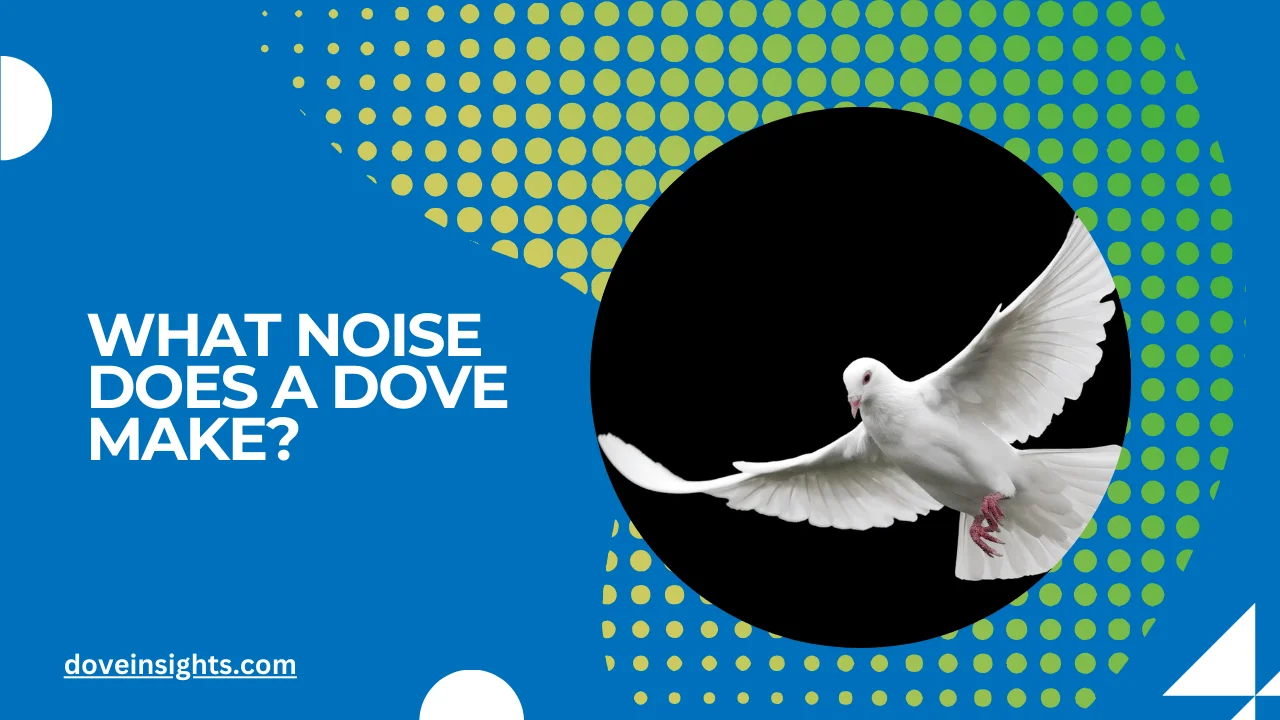Doves are among the most peaceful and serene creatures, often associated with calm skies and symbolic gestures of peace. Yet, while their gentle appearance may suggest silence, these birds communicate in ways that are both beautiful and intriguing.
If you’ve ever sat outside on a quiet morning and heard the soft cooing of a dove, you may have wondered, What is that noise they make? The dove’s distinctive sound is more than just a call—it’s a way of expressing emotions, marking territory, and communicating with others.
Understanding the sounds that doves make can deepen our appreciation of these birds and their role in nature.
This article will dive into the various noises that doves make, explain what they mean, and explore the functions behind these sounds.
Whether you’re a birdwatching enthusiast, a pet dove owner, or simply curious, the sounds of a dove are an important aspect of their communication. Doves are not only visually captivating but also rich in vocal expressions that serve a multitude of purposes.
Let’s explore what those noises are and why they matter to doves and those of us who are lucky enough to hear them.
Contents
- 1 The Most Common Sound – The “Coo”
- 2 The Sound of Mourning – The “Mourning Dove Call”
- 3 Doves’ Warning Calls and Alarm Sounds
- 4 Vocalizations in Courtship
- 5 Why Understanding Dove Sounds Matters
- 6 Conclusion:
- 7 FAQ’s
- 7.0.1 What does a dove’s coo mean?
- 7.0.2 Why do Mourning Doves make a “mourning” sound?
- 7.0.3 Do doves make other sounds besides cooing?
- 7.0.4 What is the difference between a dove’s coo and an owl’s hoot?
- 7.0.5 Do doves make sounds in the wild?
- 7.0.6 Can doves communicate with each other through sounds?
The Most Common Sound – The “Coo”
One of the most well-known and distinct sounds made by a dove is the soft, mournful “coo”. This sound is often heard in the early morning or at dusk, and it’s a comforting presence in quiet, peaceful environments. The “coo” is a soft, repetitive sound that can vary in tone and rhythm depending on the species and situation.
- Why do doves coo? The cooing sound is primarily associated with courtship and territorial marking. Male doves, especially during the breeding season, use the coo to attract females. It’s their version of a romantic serenade. Additionally, doves will coo to establish their presence in a particular area, signaling to other doves that they claim the territory. This can be seen as a form of communication between individuals of the same species, helping them avoid conflict over space and mates.
- Variations of the coo: While the general cooing sound is quite soft, it can vary in intensity and pattern. Some doves have a single coo, while others may produce a series of coos or even trumpet-like calls. These variations can be influenced by the dove’s environment or specific needs, such as signaling distress or hunger.
The Sound of Mourning – The “Mourning Dove Call”
The Mourning Dove, a popular species in North America, is known for its characteristic “mourning” call, which is a low, melancholic cooing sound. This is particularly unique to the Mourning Dove, and its name is a direct reference to the sound. The call is not only a form of communication but also carries a sense of longing or sadness, echoing its connection to the bird’s symbolic role in many cultures.
- Purpose of the Mourning Call: The “mourning” call serves several purposes, primarily territoriality and courtship. When a male Mourning Dove coos this mournful sound, it’s often signaling to other males that this area is already claimed.
- Females may also be drawn to this specific call as part of their mate selection process. It’s important to note that while the call sounds mournful to human ears, for doves, it’s an important part of their reproductive rituals.
- The Frequency of the Call: Mourning Doves tend to call in the early morning and late evening, and their calls can be heard over long distances. This gives the impression that doves are constantly mourning, but in reality, the call is a vital part of their communication strategy.
Doves’ Warning Calls and Alarm Sounds
Doves, like most birds, also have alarm calls to warn other members of their group about potential threats. These calls are typically short, sharp sounds meant to quickly alert other doves to the presence of a predator or dangerous situation.
- Characteristics of Alarm Calls: Alarm calls are more abrupt and higher-pitched compared to the cooing sounds associated with peaceful behavior.
- They are not typically melodic but serve the primary purpose of causing other doves to take notice of danger. For example, when a hawk or domestic cat approaches, doves will emit a sudden, sharp “peep” or “chirp” to signal the presence of the predator.
- Behavioral Response: The response to these alarm calls is often immediate and involves the doves flying away or hiding in dense cover like trees or bushes. Alarm calls may also serve to rally other doves, creating a group defense or distraction to evade capture.
Vocalizations in Courtship
During courtship, doves increase the frequency of their vocalizations, especially the cooing sounds. However, their vocalizations go beyond just calling or cooing; they can also involve display flights that combine vocal sounds with aerial maneuvers to attract potential mates.
- Courtship Displays: Male doves will often perform a series of flights, accompanied by deep cooing, puffing up their chest, and creating a visual spectacle to impress females. These aerial displays are often paired with a distinctive “hoo-hoo-hoo” sound. The cooing sounds are a sign of the male’s strength and health, signaling to females that he is a good mate.
- Female Response: Female doves respond to these courtship calls with quiet listening, and if they are interested, they will often join in or perform synchronized behaviors, which solidify the bond between the pair.
Why Understanding Dove Sounds Matters

Understanding the sounds that doves make is not only about appreciating their beauty but also about connecting with their social dynamics.
Doves are highly communicative, and their sounds serve various functions that help them survive, mate, and thrive in their environment. Whether you’re an avid birdwatcher, pet dove owner, or simply a nature lover, knowing the meaning behind dove sounds can enhance your appreciation for these birds.
- Dove Sounds and Symbolism: Doves are often associated with peace, love, and harmony. Their soothing coos and gentle calls embody these ideals and are heard in various spiritual and cultural settings, reinforcing their symbolic significance.
- Connection to Nature: Understanding dove sounds can deepen your connection with the natural world, allowing you to better appreciate how these birds communicate and interact with their environment.
Conclusion:
The sounds of doves are more than just background noise; they are the language of a species that has been both admired and studied for centuries. From their soft, cooing calls to their alarm sounds and courtship displays, doves use their vocalizations to communicate, mate, mark territory, and ensure their survival.
As we explore these sounds, we gain a greater appreciation for the roles that doves play in the ecosystem and their symbolic meaning in human culture.
Whether you hear the mournful call of a Mourning Dove or the gentle cooing of a pet dove, each sound carries with it a piece of the bird’s story. So next time you hear a dove, remember—it’s not just a sound, but a message being sent into the world.
And in that message lies the timeless beauty of communication in nature.
FAQ’s
What does a dove’s coo mean?
A dove’s coo generally represents territorial claims or courtship behavior. Male doves coo to attract mates, and they also use it to mark their territory and communicate with other doves in the area. The coo is often a sign of a peaceful and calm demeanor.
Why do Mourning Doves make a “mourning” sound?
The Mourning Dove’s call is often described as mournful due to its soft, melancholic tone. This sound is mainly used for territorial marking and courtship. The mourning call gives the impression of sadness, but for doves, it’s an important means of communication, especially during the breeding season.
Do doves make other sounds besides cooing?
Yes, doves also make sharp alarm calls or “peeps” to warn of danger or a predator. These calls are typically high-pitched and brief, serving as an urgent signal to alert other doves.
What is the difference between a dove’s coo and an owl’s hoot?
A dove’s coo is generally softer, repetitive, and rhythmic, while an owl’s hoot tends to be deeper and more monotonal. Both sounds are used to communicate, but the dove’s coo is most commonly for territorial and courtship purposes, while owl hoots can have a variety of meanings, including navigation or marking territory.
Do doves make sounds in the wild?
Yes, wild doves make a variety of vocalizations, including their cooing calls to communicate with others. They may also make alarm calls when predators are nearby. The sounds of wild doves vary slightly depending on the species and location.
Can doves communicate with each other through sounds?
Yes, doves primarily communicate through sounds. Their cooing, warning calls, and other vocalizations help them maintain territorial boundaries, find mates, and alert others to threats. Communication through sound is a vital part of dove social life.








